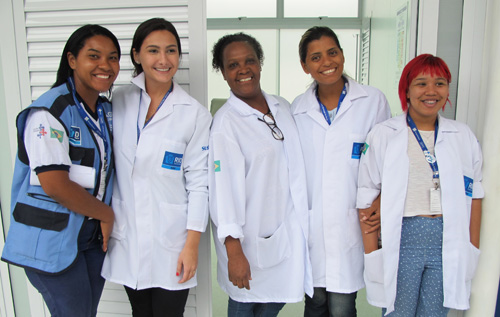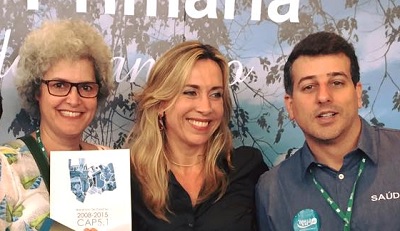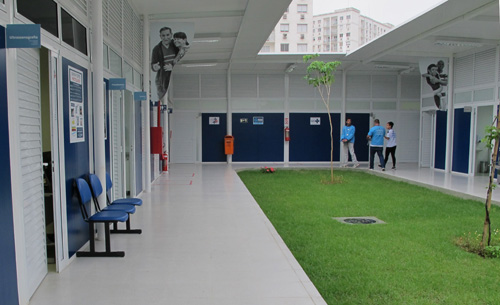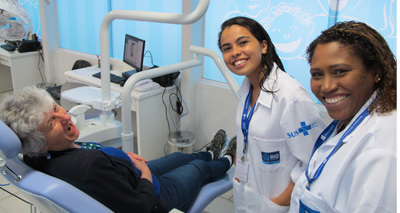Visit to two Rio health clinics
 Clinic staff (l to r): health agent Patricia, Dr Natalia M de Figueiredo, nurses Wilma, Gabrielle & Larissa
Clinic staff (l to r): health agent Patricia, Dr Natalia M de Figueiredo, nurses Wilma, Gabrielle & Larissa
WONCA Editor, Karen Flegg and WONCA South Asia Rural leader, Pratyush Kumar, numbered among many who visited primary care clinics in the progressive Brazilian Health System.
Dr Karen Flegg writes: A promise that we would change our thinking if we visited a health centre while at the Rio conference saw dozens of people lining up to attend clinics. I was lucky to be in a group, with three other English speaking colleagues, led by Dr Betina Durovni, Undersecretary for Primary Care in the Rio de Janeiro Health Department.

Photo: Rio Health leaders, Dr Betina Durovni, Undersecretary, (left) and Dr Daniel Soranz, Secretary (right), with another colleague.
There are 107 community health centres built and operated on the same model in Rio and more than 122 older adapted clinics that were already operating before the changes in 2008-09.
Our clinic visit was conducted at Clinica da Família Maicon Siqueira – a very new clinic set up just before the Olympics but already with 25% of its target population of 25,000 registered. The geographical area covered by this clinic is divided into 8 regions of approximately equal population. Each region has a team that looks after its health care – one doctor, one nurse and six community health workers (“agents”). The health agents live in the region, are lay people with a month of initial training and then more ongoing. They know their population, they visit their population in their homes, one of them waits in the health centre in reception for anyone who comes in.
The clinic is open 8am-8pm Monday to Friday and 8am- 12 noon on Saturday. Each doctor works 40 hours week and has time in the clinic and time on home visits. Teams cooperate in the clinic to cover a doctor or nurse who is doing home visits or on rostered time off. Fifty percent of patients “drop in” without an appointment.

Photo: Inside the clinic rarely seen with no patients.
The actual clinic building is custom designed and built (as all 107 Rio clinics are) with two rows of rooms along a central grassy courtyard. There are consultation rooms, rooms for dressings, baby checks and meetings. There are X-ray and Ultrasound, venepuncture, and dental services on site. Some ‘Point of care’ testing eg HIV rapidtest is available. Electronic medical records (EMR) were given much consideration before installation in order to ensure data collection and collation between centresThe EMR enables quick monitoring of teams reporting the performance payment system.
The Primary Care Clinics are now the largest placement for residents in Community and Family Medicine in the country, both for physicians as nurses. This together with the students from private and public universities make the Family Clinics a dynamic training system for the Brazilian Health System.
The pharmacy provides drugs from a list of over 100 items. One month’s supply is given and while the list is restricted, most classes of commonly used drugs seemed represented , and some with a choice. We noted three diuretics, two ACE inhibitors, a choice of oral contraceptives. As in the hotels in Brazil, condoms are also freely available.
More integration - the public health officers who go out and physically check their regions for example, for water suitable for mosquito breeding, now go out with the Health agents. This integration has seen them accepted not hated in their communities and needless to say will see them more effective in doing their job. Community involvement in management means meetings are held to discuss proposals with nominated community representatives. Everything designed to increase ‘buy-in’ and participation of the community in their health service.
 Photo: Prof Felicity Goodyear-Smith, Chair of WONCA’s research
Working Party in the dental chair with dental auxillary staff, Simone
and Jamelle
Photo: Prof Felicity Goodyear-Smith, Chair of WONCA’s research
Working Party in the dental chair with dental auxillary staff, Simone
and Jamelle
Yes you can go to a private family doctor and either pay a lot of money or bill your very expensive health insurance .. but why would you? The IT is set to collate data and while some outcomes are already showing improvement, like hospital admissions for ‘primary care sensitive’ conditions and tuberculosis cure rates, it seems possible that given a little more time, huge positive benefits will be recorded in morbidity and mortality and these will revolutionise primary health care in other places. In Brazil, 70% of the country have a primary care structure that is similar to Rio so positive outcomes can be expected to have a significant effect.
see 2016 paper by Soranz el
Dr Pratyush Kumar, the chair of our WONCA Rural South Asia (WoRSA) group also attended this clinic but he also went to another clinic in one of the favelas. Pratyush writes: Only two of us visited favelas and it was arranged by Rio health secretary, Dr Daniel Soranz.
I went to the favela clinic on a Monday, which is considered most hectic day of the week.
They have different architecture, with a wooden floor and roof and aluminium walls. It looks similar to the urban clinic. They have armed security staff at the entrance as violent clashes are common in favelas.
As far as the health model is concerned it's the same. But there is a difference in prevalence of cases. There were more reported cases of early pregnancy (the last case was of pregnancy at 11 years of age).
They have a 24hrs emergency service at the favela clinic which was not the case in the urban centre and there are more units than in the urban centre.
In both types of clinics there are many pictures of children, men, women on their wall. They have taken pictures of people living in the clinic area and have put them up on their walls to encourage community participation. These are small things but they carry a strong message from administrators towards making their health system more accessible and people friendly.